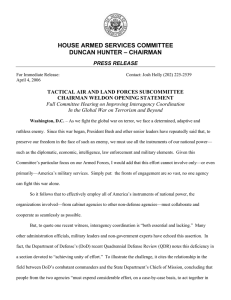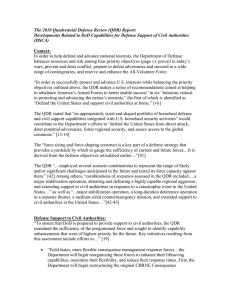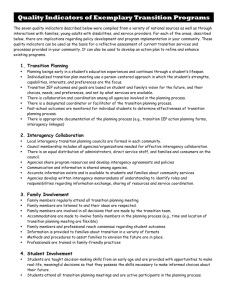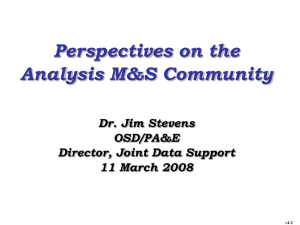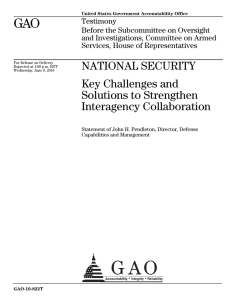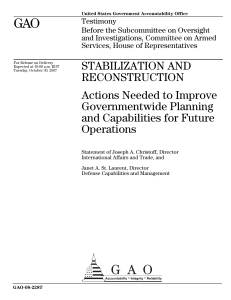STATEMENT OF ADMIRAL E. P. GIAMBASTIANI, USN VICE CHAIRMAN OF THE
advertisement
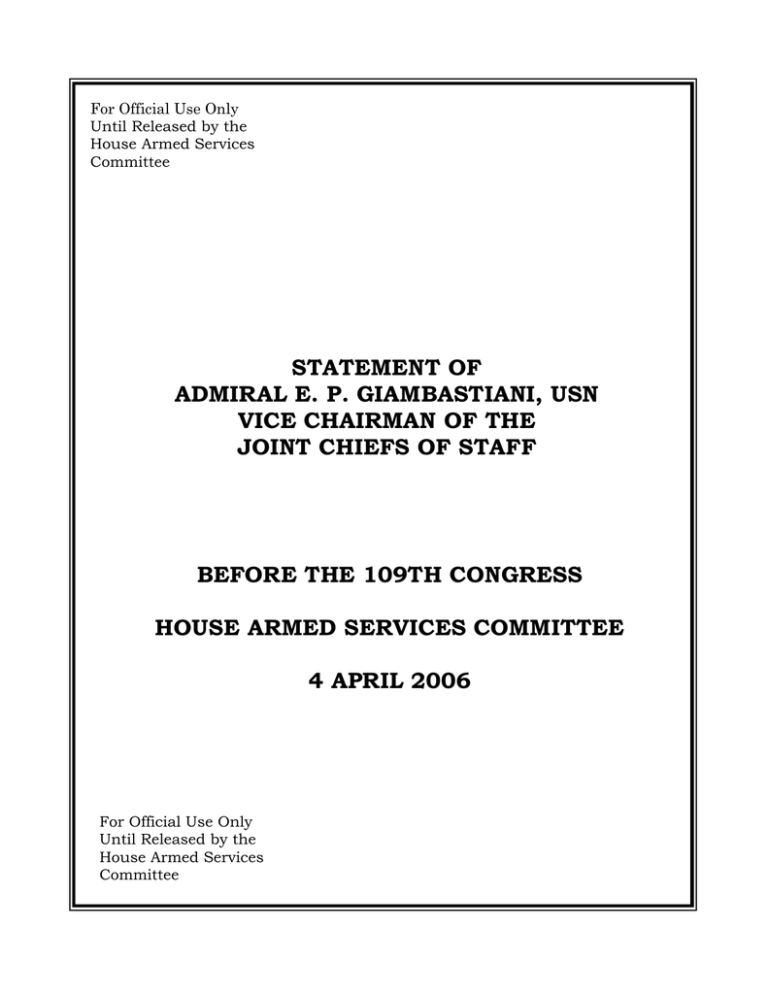
For Official Use Only Until Released by the House Armed Services Committee STATEMENT OF ADMIRAL E. P. GIAMBASTIANI, USN VICE CHAIRMAN OF THE JOINT CHIEFS OF STAFF BEFORE THE 109TH CONGRESS HOUSE ARMED SERVICES COMMITTEE 4 APRIL 2006 For Official Use Only Until Released by the House Armed Services Committee 1 Chairman Hunter, Mr. Skelton, and other distinguished members of the Committee, thank you for the opportunity to appear before you today. First though, on behalf of all Soldiers, Sailors, Airmen, Marines, and our families, thank you for your continued bipartisan support. That support has been exemplified this past year by Congressional visits to our troops in Iraq, Afghanistan, and elsewhere around the world; visits to those hospitalized; your funding for operations; your support of transformation and recapitalization initiatives; and the improved pay and benefits you have provided to our Service members and their families. I am especially pleased to be here to speak about interagency coordination, a critical issue. In my almost 40 years in uniform, I have experienced two events that have truly transformed the Department of Defense: • The move to an All-Volunteer Force, mandated by Congress in 1973; and • The passage of the Goldwater-Nichols Act Department of Defense Reorganization Act of 1986. Goldwater-Nichols’ success proves its value as a model for improving integration among disparate but related organizations that share a common goal. DoD’s experience in implementing Goldwater-Nichols provides us with particular insights into the challenges ahead as we seek to expand that success throughout the Federal Government. I want to make three main points about improving interagency cooperation, and then I look forward to engaging in a dialogue with you on where we go from here. First, I want to briefly review actions already underway to better improve interagency efforts, both at the national level and within DoD. At the national level, most of our effort has been focused on military support to stability, security, transition and reconstruction (SSTR) activities. National 2 Security Presidential Directive-44, “Management of Interagency Efforts Concerning Reconstruction and Stabilization,” set the State and Defense Departments on track to unify their SSTR efforts. DoD has taken steps to implement NSPD-44 through the DOD Directive on military support to SSTR operations, signed out on November 28, 2005. Perhaps most importantly, this Directive establishes SSTR operations as a core military mission, on par with combat operations. This builds on the Stability Operations Joint Operating Concept, which joined joint concepts on Major Combat Operations, Homeland Defense and Strategic Deterrence. As a Combatant Command, Joint Forces Command led the SSTR effort. DoD has also been looking more broadly at interagency requirements. Better integrating DoD’s capabilities into the national effort was a key topic of the 2006 Quadrennial Defense Review, or QDR. The QDR concluded that we in DoD need to do more to share expertise in planning, training, and professional development and education with our partners in the federal government and with key allies and friends. To ensure DoD’s senior leaders don’t lose sight of our progress, we have directed the development of a roadmap tracking our efforts to build partner capabilities. This roadmap is currently being staffed, but will be publicly available as soon as it is approved. These efforts build on actions already underway both outside and inside DoD. As a Combatant Commander, I directed intense and substantial support to the State Department’s effort to stand up the Coordinator for Reconstruction and Stabilization (S/CRS), commissioned in July 2004. S/CRS is a huge step forward in our national ability to develop concepts, experiment, and exercise together, and to build interagency capabilities that are particularly important for the civilian workforce. 3 We also have a great model that has been operational in Southern Command since 1994, when an existing military Joint Task Force combating the drug trade in the Caribbean and Eastern Pacific was transformed into a Joint Interagency Task Force called JIATF-South. This unique task force is composed of joint, interagency, and international personnel, including members from all of the military services, many US Federal law enforcement agencies, a large number of intelligence agencies, and liaison officers from 13 countries. Second, though we’re making progress, improving the integration of various agencies is, in my view, an area ripe for further transformation. The Global War on Terror is primarily a communications, cultural, political, economic, and diplomatic war, with strategically-important security and military components. In Iraq and Afghanistan, for example, most of the key activities for success are the responsibility of organizations beyond the uniformed military. Security is a prerequisite, but other agencies must step up to solidify progress. Most of our interagency counterparts are beginning to take steps to build capabilities within their own departments. However, in my judgment, at the Federal level we can improve upon our structure, authorities, and tools to more effectively integrate executive branch actions in the Global War on Terror. As always, it is harder to identify solutions than problems, and I don’t know what all of the potential solutions might be. There are, however, areas where you can help. Section 1206 of the FY06 National Defense Authorization Act authorized the Secretary of Defense to build the capacity of foreign countries to conduct counterterrorist or stability operations. We thank you for your support for this key provision, but more needs to be done. I believe Undersecretary of Defense for Policy Edelman will testify before you on this issue on Friday. 4 I also appreciate your help with Section 1207 of the FY06 authorization bill, which enhances interagency cooperation by authorizing the Secretary of Defense to transfer funds to the Secretary of State for the purpose of facilitating reconstruction, security or stabilization assistance to a foreign country. This is another key step toward helping us work together more effectively with both our interagency and international partners. Finally, I ask for your support for the FY07 request for State’s Coordinator for Reconstruction and Stabilization office. As mentioned earlier, this is a critical capability to help us build our capacity and break out of our traditional stovepipes. My third and final point is that we have a long road ahead. The first step is an ongoing dialogue; I hope this hearing is just the beginning of our work together to realize the full potential of a truly integrated interagency process. Goldwater-Nichols taught us that we need multiple pressure points to sustain forward momentum. “Formal” players and processes are key, and Congress in particular has a critical role to play. I would encourage you to develop strategies to find a way ahead through the complex issues of committee jurisdiction and span of control so that the executive and legislative branches can move forward in tandem. As we work this issue through the QDR roadmap process, DoD will propose legislation that will further enhance our ability to work more effectively with the Department of State and US Agency for International Development (AID). We would greatly appreciate your support for these requests, as they allow us to begin to change culture, processes, and action on the ground in support of our counter-terrorist policies. 5 We should not stop there; we also have to think about our national assets. Only 18 percent of our GDP is generated by the federal government. Therefore, when we think about applying all of our national capabilities, we also have to consider elements outside of government. That is why a wideranging conversation is needed, to include experts in think tanks and academia – the work begun by the Center for Strategic and International Studies on Beyond Goldwater-Nichols is just one example of type of work that can help. Those are the three points I wanted to make to begin our discussion: • We are making some progress; • Further transformation is required; and • We all have a part in finding the solution Thank you again for the opportunity to be here. I look forward to your questions, and to continuing to work with you on this critical issue. 6
